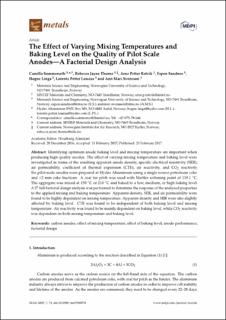| dc.contributor.author | Sommerseth, Camilla | |
| dc.contributor.author | Thorne, Rebecca Jayne | |
| dc.contributor.author | Ratvik, Arne Petter | |
| dc.contributor.author | Sandnes, Espen | |
| dc.contributor.author | Linga, Hogne | |
| dc.contributor.author | Lossius, Lorentz Petter | |
| dc.contributor.author | Svensson, Ann Mari | |
| dc.date.accessioned | 2020-12-15T10:58:25Z | |
| dc.date.available | 2020-12-15T10:58:25Z | |
| dc.date.created | 2017-03-14T14:09:54Z | |
| dc.date.issued | 2017 | |
| dc.identifier.issn | 2075-4701 | |
| dc.identifier.uri | https://hdl.handle.net/11250/2719504 | |
| dc.description.abstract | Identifying optimum anode baking level and mixing temperature are important when producing high quality anodes. The effect of varying mixing temperature and baking level were investigated in terms of the resulting apparent anode density, specific electrical resistivity (SER), air permeability, coefficient of thermal expansion (CTE), air reactivity, and CO2 reactivity. Six pilot-scale anodes were prepared at Hydro Aluminium using a single source petroleum coke and <2 mm coke fractions. A coal tar pitch was used with Mettler softening point of 119.1 °C. The aggregate was mixed at 150 °C or 210 °C and baked to a low, medium, or high baking level. A 22 full-factorial design analysis was performed to determine the response of the analyzed properties to the applied mixing and baking temperature. Apparent density, SER, and air permeability were found to be highly dependent on mixing temperature. Apparent density and SER were also slightly affected by baking level. CTE was found to be independent of both baking level and mixing temperature. Air reactivity was found to be mainly dependent on baking level, while CO2 reactivity was dependent on both mixing temperature and baking level. | en_US |
| dc.language.iso | eng | en_US |
| dc.publisher | MDPI | en_US |
| dc.rights | Navngivelse 4.0 Internasjonal | * |
| dc.rights.uri | http://creativecommons.org/licenses/by/4.0/deed.no | * |
| dc.subject | factorial design | en_US |
| dc.subject | anode performance; | en_US |
| dc.subject | effect of baking level; | en_US |
| dc.subject | effect of mixing temperature; | en_US |
| dc.subject | carbon anodes; | en_US |
| dc.title | The Effect of Varying Mixing Temperatures and Baking Level on the Quality of Pilot Scale Anodes - A Factorial Design Analysis | en_US |
| dc.type | Peer reviewed | en_US |
| dc.type | Journal article | en_US |
| dc.description.version | publishedVersion | en_US |
| dc.rights.holder | Copyright: the authors. This is an open access article distributed under the Creative Commons Attribution License which permits unrestricted use, distribution, and reproduction in any medium, provided the original work is properly cited | en_US |
| dc.source.volume | 7 | en_US |
| dc.source.journal | Metals | en_US |
| dc.source.issue | 3 | en_US |
| dc.identifier.doi | 10.3390/met7030074 | |
| dc.identifier.cristin | 1458270 | |
| dc.relation.project | Norges forskningsråd: 236665 | en_US |
| dc.source.articlenumber | 74 | en_US |
| cristin.unitcode | 7401,80,3,0 | |
| cristin.unitname | Bærekraftig energiteknologi | |
| cristin.ispublished | true | |
| cristin.fulltext | original | |
| cristin.qualitycode | 1 | |

